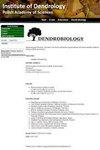Syntaxonomy and ecology of thermophilous deciduous open woodlands and scrub vegetation in Tajikistan (Middle Asia)
IF 1.8
4区 农林科学
Q2 FORESTRY
引用次数: 3
Abstract
In this paper we present the first syntaxonomic classification for the thermophilous open wood and scrub vegetation in Tajikistan with some remarks on its environmental gradients. Altogether 143 relevés were sampled between 2014–2021 using the seven-degree cover-abundance scale of Braun-Blanquet. They were classified by the modified TWINSPAN method with the use of the four step interval scale with cutoff levels of 0%, 2%, 5% and 10% and total inertia as a measure of cluster heterogeneity. Diagnostic species were identified using the phi coefficient as a fidelity measure. Detrended Correspondence Analysis was used to determine the relation between samples, vegetation units and the major gradients in species composition. Plant communities have been divided into three main groups: (1) dry scrub on screes, (2) mesophilous scrubs in nemoral zone, and (3) open woods. A new class of Pistacietea khinjuki-verae has been proposed for open woods. Further classification of vegetation data resulted in the distinction of four plant communities within two provisional alliances: Roseion kokanicae and Ranunculo tenuilobi-Cotoneasterion hissaricae (communities of Rosa kokanica and R. ecae, associations of Aveno ludovicianae-Rhuidetum coriariae and Calophacetum grandiflorae). Additionally, we established the Pistacion verae alliance for the pistachio groves of Middle Asia with two subassociations: Pistacietum verae typicum and Pistacietum verae cercidetosum griffithii. The main factors determining the species composition of the studied communities are: elevation, temperature, precipitation, slope and aspect. Our research showed that the Pistacia groves are a distinct vegetation typical of the Irano-Turanian area and that further surveys are needed to present a final classification of scrub vegetation of Tajikistan.塔吉克斯坦(中亚)喜热落叶开放林地和灌丛植被的系统分类学和生态学
本文首次提出了塔吉克斯坦喜热开阔林地和灌丛植被的分类学分类,并对其环境梯度作了评述。在2014-2021年期间,使用布朗-布朗凯的7度覆盖丰度量表对143个相关的 物质交换瘤进行了抽样。采用改进的TWINSPAN方法进行分类,使用四步间隔量表,截断水平为0%,2%,5%和10%,总惯性作为集群异质性的度量。使用phi系数作为保真度度量来鉴定诊断种。采用非趋势对应分析确定了样品、植被单元与物种组成主要梯度之间的关系。植物群落主要分为三大类:(1)干灌丛,(2)沼泽地带的中温灌丛,(3)开阔林地。开阔林中发现了一种新的开阔林黄连木属。进一步对植被数据进行分类,划分出了4个植物群落,分别属于两个临时联盟:蔷薇科(Roseion kokanicae)和柽柳科(Ranunculo tenuilobi-Cotoneasterion hissaricae)(蔷薇和红蔷薇群落、黄蔷薇-大黄蔷薇群落和大花萼(Calophacetum plantiflorae))。此外,我们还建立了中亚开心果林亚分会:典型开心果(Pistacietum verae typicum)和格里菲开心果(Pistacietum verae cercidetosum griffithii)。决定研究群落物种组成的主要因素有:海拔、温度、降水、坡度和坡向。我们的研究表明,黄连木林是伊朗-图兰地区典型的独特植被,需要进一步的调查来提出塔吉克斯坦灌丛植被的最终分类。
本文章由计算机程序翻译,如有差异,请以英文原文为准。
求助全文
约1分钟内获得全文
求助全文
来源期刊

Dendrobiology
农林科学-林学
CiteScore
2.20
自引率
11.10%
发文量
17
审稿时长
>12 weeks
期刊介绍:
Dendrobiology publishes original research articles and review articles related to the biology of trees and shrubs.
 求助内容:
求助内容: 应助结果提醒方式:
应助结果提醒方式:


